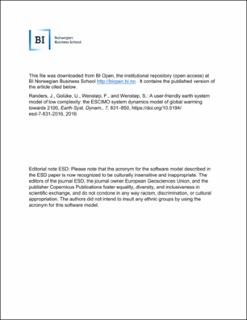A user-friendly earth system model of low complexity: the ESCIMO system dynamics model of global warming towards 2100
Peer reviewed, Journal article
Published version
Permanent lenke
https://hdl.handle.net/11250/2998506Utgivelsesdato
2016Metadata
Vis full innførselSamlinger
- Scientific articles [2181]
Sammendrag
We have made a simple system dynamics model, ESCIMO (Earth System Climate Interpretable Model), which runs on a desktop computer in seconds and is able to reproduce the main output from more complex climate models. ESCIMO represents the main causal mechanisms at work in the Earth system and is able to reproduce the broad outline of climate history from 1850 to 2015. We have run many simulations with ESCIMO to 2100 and beyond. In this paper we present the effects of introducing in 2015 six possible global policy interventions that cost around USD1000billion per year– around 1%ofworldGDP.Wetentatively conclude (a) that these policy interventions can at most reduce the global mean surface temperature– GMST– by up to 0.5◦C in 2050 and up to 1.0◦C in 2100 relative to no intervention. The exception is injection of aerosols into the stratosphere, which can reduce the GMST by more than 1.0◦C in a decade but creates other serious problems. We also conclude (b) that relatively cheap human intervention can keep global warminginthis century below +2◦Crelative to preindustrial times. Finally, we conclude (c) that runaway warming is unlikely to occur in this century but is likely to occur in the longer run. The ensuing warming is slow, however. In ESCIMO, it takes several hundred years to lift the GMST to +3◦C above preindustrial times through gradual self-reinforcing melting of the permafrost. We call for research to test whether more complex climate models support our tentative conclusions from ESCIMO.

